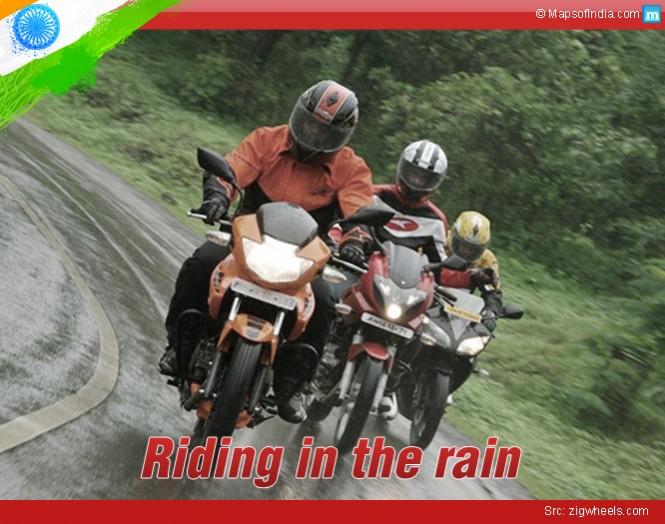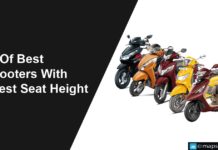The monsoon brings with it one of the most popular seasons for an activity most of us connect and relate to – biking. For us Indians, rains are an excuse to get on our wheels and relieve our bodies and minds of the day to day stress, work load effect, and monotony of life.
With riding in the rain comes a slightly greater risk and hence an automatic requirement of the need for an elevated sense of road and ride responsibilities. For as much as getting drenched and feeling the spray of wind and water droplets on our face may appeal to us, the wet roads, with numerous potholes, and rain water caused mud and grime, are an open invitation for disaster waiting to happen.
It is hence of utmost importance for all those who simply cannot resist taking their rides out in the rain, to keep a few key pointers in mind.
Safety gear essential
The first and the foremost thing requiring our attention is safety gear. Irrespective of whether it is raining or not, riders are always expected to wear full protective gear when out riding, since one isn’t of much use to their motorcycle, or to anyone else for that matter, when they’re lying bed ridden post a crash. Not everyone has had the thought stroke of having bought a riding jacket – I myself am thankful to a couple of close friends who share the same passion of biking, to have guided me towards buying a decent riding jacket with in-seam body armour and a pair gloves with gauntlets. These are still not as important as the most basic safety gear, which sadly most of us choose to ignore to put to use – helmets, and shoes.
Before anything, comes a full face helmet (advised) but even a half-faced one would do, as long as you have the brains and the sense to ensure their safety – by putting one on. For all injuries – scratches, bruises, or even impact wounds and fractures, heal eventually, head injuries may not. So use your head, protect it, and wear a helmet. Believe me, there is nothing cooler than a biker in full gear – even visually so, except maybe the KTM 1290 Superduke R, and one would still be a complete disgrace to biking if they got on it without riding gear.
Next, come shoes, and at the least a good pair of jeans, for if you skid and fall, and in case the injury’s a tad too much to continue riding with, you can atleast get back up and ride home or to a hospital – whichever’s closer. I would still advise you to get riding boots that go all the way above your ankles and partially cover your lower legs and knee pads as well, but knowing that hardly a few would actually comply, I’d say shoes and jeans would still do half the trick.
Tyres are what keep you on your ride and your ride on the road (except for maybe those who choose to get off it and into the dirt, but that’s a different matter altogether and is called off roading). So, before you get on that ride and bring the engine to life, stop, dismount, and check your tyres. The air pressure should be just on or even slightly below the set limit as excessive air reduces the tyres’ contact area increasing the chances of losing grip on the road. Lesser area causes the tyre to compress slightly more and allow a greater surface to surface contact with the road giving you a better grip.
Controlling the speed
Avoid going at extreme speeds even if you decide to hit the highway since wet roads and hard braking donot always get along and if your wheels decide to lock, you’re in for a rough and might I add, painful one. Brakes are meant to slow us down, and not bring us to a complete halt – something that most of us forget when we need to remember it the most. It is also important to adhere to decent – not excessive speeds – as water on the roads can lead to aquaplaning – a condition in which the tyres completely lose direct contact with the road and are in free motion over water on the road and one should never apply full brakes in such conditions.
It is important to know how to downshift to control speed when brakes would prove to be more of a risk than an asset. If you’re already running on low gear and high rpm, letting go of the throttle, tapping the frontal disc – mind you – only tapping it slightly to reduce speed and then shifting down to a lower gear, brings down speed from the engine itself, preventing the wheels and then the bike from giving into momentum. As you downshift and feel the bike lose speed with a lurch it is imperative to start applying both the brakes simultaneously and again, only tapping or squeezing the brake levers slightly should do the trick. Always remember, that specially in rains, sudden impulsive reactions can cause skidding and even crashes.
One should always keep a check on the chain lube as well as keeping the chain and sprocket clear of mud and grime because they can easily stick to the chain and travel to the front sprocket. Excessive deposit of grime can cause the sprocket to lock and your vehicle to skid.
Last but not the least, take care of your fellow travelers. Do not overtake from the wrong side and and avoid speeding specially in crowded areas. Always remember, carelessness is a disaster waiting for happen – not just for you, but for someone else too.
So get in your safety gear, get on that bike, ride safe, ride responsibly and be sure to have fun.




